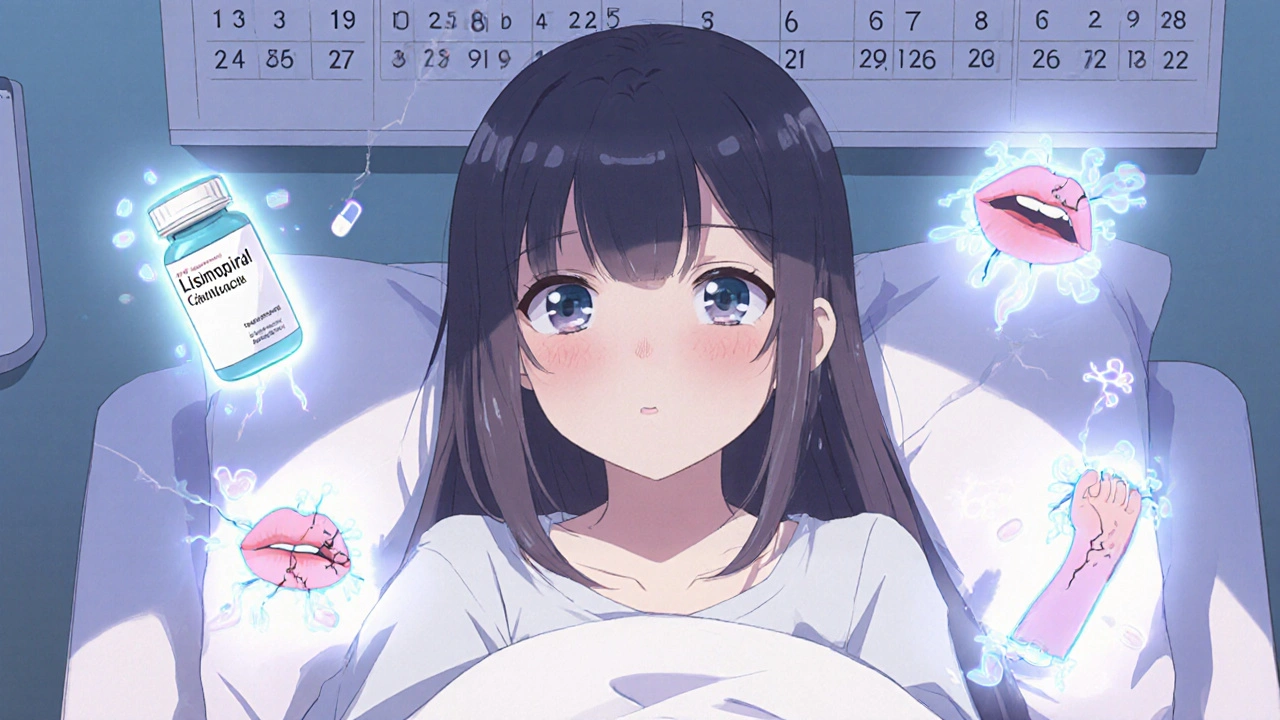Delayed Medication Side Effects Checker
Check if your medications might cause delayed reactions. This tool identifies potential late-onset side effects based on the article's research. Always consult your doctor for medical advice.
Medication Check
Potential Delayed Reactions
What to do next
- Keep a drug diary - Note medication start dates and any new symptoms
- Don't ignore vague symptoms - Fatigue, tingling, or joint pain may be drug-related
- Bring your list to appointments - Include all medications and symptoms
What if the medicine you’ve taken safely for years suddenly starts making you sick-without warning? You’re not imagining it. Thousands of people experience delayed medication side effects long after they’ve stopped worrying about side effects. These aren’t the nausea or dizziness that show up on day two. These are reactions that creep in weeks, months, or even years later. And because they don’t match the timeline most doctors expect, they’re often missed-until it’s too late.
Why Delayed Reactions Are So Dangerous
Most people assume if a drug hasn’t hurt them in the first few days, it’s safe. That’s a dangerous myth. The World Health Organization estimates that 5% of all hospital admissions are due to adverse drug reactions, and nearly a third of those are delayed. These reactions don’t follow the usual clock. A drug like lisinopril, taken daily for seven years without issue, can suddenly cause your tongue and throat to swell shut in the middle of the night. Or a course of ciprofloxacin for a urinary infection might lead to a torn Achilles tendon six months later, even though you’re no longer taking it.Why does this happen? Your body doesn’t react the same way every time. Sometimes, the immune system slowly builds up a response. Other times, the drug quietly damages organs over time-like proton pump inhibitors (PPIs) eating away at your magnesium levels, or metformin quietly lowering your vitamin B12. These changes are silent. You feel fine until one day, you can’t walk, you’re dizzy, or your skin is covered in blisters.
Common Drugs That Cause Delayed Reactions
Some medications are far more likely to cause late-onset problems than others. Here are the top culprits, backed by clinical data:- ACE inhibitors (lisinopril, enalapril, ramipril): Can trigger angioedema-swelling of the face, lips, tongue, or throat-after years of safe use. One patient in Illinois described it: “I’d been on lisinopril for seven years. Then one night, my tongue swelled shut. The ER almost intubated me before I mentioned the drug.”
- Fluoroquinolone antibiotics (ciprofloxacin, levofloxacin): The FDA strengthened its warning in 2018 after over 1,000 reports of tendon rupture months after treatment ended. The damage can happen even if you’ve been inactive or haven’t exercised.
- Proton pump inhibitors (omeprazole, esomeprazole): Used for heartburn, but after two or more years, they can cause severe magnesium deficiency, kidney damage, and increase fracture risk. A 2019 JAMA study found vitamin B12 deficiency rises by 112% after four years of daily use.
- Metformin: The most common diabetes drug can cause B12 deficiency after four years. Symptoms-fatigue, numbness, memory issues-are often mistaken for aging or diabetes progression.
- Corticosteroids (prednisone): Used for asthma, arthritis, or autoimmune conditions. After years, they cause osteoporosis, cataracts, diabetes, and muscle wasting. These effects are slow, so patients don’t connect them to the drug.
- Antiepileptics (carbamazepine, phenytoin): Can trigger DRESS syndrome or Stevens-Johnson Syndrome weeks after starting. In people with the HLA-B*15:02 gene, the risk of life-threatening skin reactions jumps from 0.01% to over 50%.
Types of Delayed Reactions and When They Show Up
Not all delayed reactions are the same. They fall into clear patterns based on timing and symptoms:- Type IV hypersensitivity (delayed immune reaction): Appears 48 hours to 8 weeks after starting the drug. Includes DRESS syndrome-fever, rash, swollen lymph nodes, and organ damage (liver, kidneys). Often mistaken for a virus.
- Severe Cutaneous Adverse Reactions (SCARs): Stevens-Johnson Syndrome (SJS) and Toxic Epidermal Necrolysis (TEN) can develop 1-4 weeks after starting drugs like allopurinol or lamotrigine. Mortality for TEN can hit 50%.
- Drug-induced lupus: From medications like procainamide or hydralazine. Symptoms like joint pain, rash, and fatigue appear after 6-12 months. Stops when the drug is stopped.
- Neurological reactions: Akathisia (restlessness, inability to sit still) from antipsychotics like haloperidol shows up after 5-7 days. Often misdiagnosed as anxiety.
- Chronic organ damage: PPIs and metformin cause slow, cumulative harm. B12 deficiency, kidney stones, or low magnesium build up silently over years.

Who’s at Highest Risk?
Some people are far more likely to experience delayed reactions. You’re at higher risk if:- You’re over 65. Older adults make up 25% of ER visits for drug reactions-even though they’re only 16% of the population.
- You have a genetic marker. HLA-B*15:02 increases carbamazepine-induced SJS risk by 50-80%. HLA-B*57:01 raises the risk of abacavir hypersensitivity.
- You’re a woman. Women experience delayed hypersensitivity reactions 1.5 to 2 times more often than men.
- You have an autoimmune disease. People with Crohn’s or ulcerative colitis on thiopurines have a 12-fold higher risk of DRESS syndrome.
- You’re on multiple medications. Polypharmacy increases the chance of hidden interactions that trigger delayed reactions.
How Doctors Miss These Reactions-and How to Prevent It
Most doctors aren’t trained to think about side effects that appear months later. They look for immediate reactions: rashes, swelling, breathing trouble within hours. Delayed reactions don’t fit that mold. A patient with DRESS syndrome might be treated for mononucleosis. Someone with tendon pain after ciprofloxacin might be told they’re just “getting older.”Here’s what you can do:
- Keep a drug diary. Write down every medication you take-even vitamins and OTC drugs. Note the start date.
- Ask yourself: “When did this start?” If a new symptom appeared after you started a new drug-even if it was six months ago-flag it.
- Bring your list to every appointment. Don’t assume your doctor remembers what you took six months ago. Show them.
- Don’t ignore vague symptoms. Fatigue, tingling, joint pain, skin changes, or trouble speaking aren’t always “just aging.” They could be drug-related.
- Request testing if needed. Skin patch tests can confirm delayed allergies with 70-80% accuracy if done 4-6 weeks after the reaction. Lymphocyte transformation tests are 85-90% accurate for immune-mediated reactions.
Dr. Sarah Johnson, Director of the Drug Hypersensitivity Clinic at NYU Langone, says: “When a patient presents with multi-organ symptoms and eosinophilia-especially if they started a new drug 2-8 weeks ago-we immediately suspect a drug reaction. We don’t wait for a rash to spread.”
What to Do If You Suspect a Delayed Reaction
If you think a medication is causing a late-onset problem:- Stop the drug immediately. But don’t stop critical meds like blood pressure or seizure drugs without talking to your doctor.
- Call your prescriber. Don’t wait for your next appointment. Call today.
- Go to the ER if you have swelling, trouble breathing, or widespread blistering. These are medical emergencies.
- Report it. File a report with the FDA’s MedWatch program. Your report helps others.
- Ask for a referral. Request a specialist in drug hypersensitivity or clinical pharmacology.
One patient on Reddit wrote: “I was told my rash was ‘just eczema’ for three months. By the time they realized it was DRESS, my liver was failing. I almost died.”

The Future: Predicting Reactions Before They Happen
The good news? Science is catching up. The FDA’s Sentinel Initiative now tracks over 200 million patient records to predict who’s at risk. Genetic screening for high-risk alleles (like HLA-B*15:02) is already used in some countries before prescribing carbamazepine. By 2025, routine pre-prescription genetic testing for delayed reactions could prevent tens of thousands of severe cases each year.Researchers are also developing algorithms that flag patients based on age, gender, medications, and lab values. Within five years, your doctor might get an alert: “Patient has HLA-B*57:01. Avoid abacavir.”
Until then, awareness is your best defense.
Frequently Asked Questions
Can delayed medication side effects happen years after stopping the drug?
Yes. Some reactions, like tendon damage from fluoroquinolones, can appear up to six months after you stop taking the drug. Others, like osteoporosis from long-term steroids or B12 deficiency from metformin, develop slowly over years-even after the drug is no longer in your system. The damage is cumulative.
Are delayed side effects more common in older adults?
Absolutely. People over 65 are 1.6 times more likely to be hospitalized for adverse drug reactions than younger adults. Their bodies process drugs differently, they often take multiple medications, and organ function declines with age. This makes them more vulnerable to slow, cumulative damage from drugs like PPIs, diuretics, and anticholinergics.
How do I know if my symptoms are from a drug or something else?
Ask yourself: Did this symptom start after I began a new medication-even if it was months ago? If you’re unsure, look at your drug list. A new rash, fatigue, joint pain, or tingling that began after starting a drug is suspicious. If symptoms improve after stopping the drug and return when you restart it, that’s a strong sign it’s drug-related. Always tell your doctor about this pattern.
Can I get tested to see if I’m at risk for delayed reactions?
Yes-for some drugs. If you’re prescribed carbamazepine, phenytoin, or abacavir, genetic testing for HLA-B*15:02 or HLA-B*57:01 is recommended before starting. Skin patch testing can also confirm delayed allergies, but it must be done 4-6 weeks after the reaction has cleared. Blood tests for eosinophils and liver enzymes can support the diagnosis, but they don’t confirm the cause.
What should I do if my doctor dismisses my concerns?
Be persistent. Bring printed information from reputable sources like the FDA, Mayo Clinic, or NIH. Mention specific reactions like DRESS, SJS, or fluoroquinolone tendon damage. Ask: “Could this be a delayed drug reaction?” If they still dismiss it, request a referral to a clinical pharmacologist or allergy specialist. Your life may depend on it.
Next Steps
If you’re on long-term medication, take action now:- Review your entire drug list with your doctor.
- Ask: “Could any of these cause problems after months or years?”
- Get blood tests for B12, magnesium, and kidney function if you’ve been on PPIs or metformin for over two years.
- Keep a symptom journal. Note when new issues start and what you were taking at the time.
- Know your family’s genetic history. If someone had a severe reaction to a drug, tell your doctor.
Delayed side effects aren’t rare. They’re underdiagnosed. The more you know, the safer you are.

Comments (11)
Mike Laska
November 1, 2025 AT 06:46
My uncle took lisinopril for 9 years. One morning he woke up with his tongue the size of a baseball. ER said it was angioedema. They didn’t even ask about his meds until his wife screamed, ‘He’s been on that pill since 2014!’ Now he’s on a different BP med and carries an epinephrine pen like it’s a damn phone. Why isn’t this on every prescription label? Why do we only hear about this after someone almost dies?
Hazel Wolstenholme
November 1, 2025 AT 11:21
One cannot help but observe the alarming epistemological lacuna in contemporary pharmacovigilance paradigms. The biomedical establishment remains stubbornly tethered to a temporal myopia-assuming safety equates to absence of acute toxicity. Yet, as the data so meticulously delineated herein reveals, the pharmacokinetic ballet of chronic drug exposure often culminates in insidious, systemic derangements: mitochondrial dysfunction, epigenetic modulation, and delayed immune sensitization. One might even posit that our current regulatory frameworks are not merely inadequate-they are ontologically misaligned with the chronobiology of human physiology.
Zachary Sargent
November 2, 2025 AT 15:47
So basically every pill you take is a time bomb? Thanks for the mental health break.
Pradeep Kumar
November 3, 2025 AT 18:39
My mom was on omeprazole for 8 years. She got really tired, started forgetting names, felt like her legs were asleep all the time. Doctor said it was ‘just aging.’ We finally got her B12 checked-level was 180. After supplements, she’s back to gardening and telling jokes. Don’t ignore the quiet symptoms. They’re screaming.
Ajay Kumar
November 3, 2025 AT 19:50
Look, I get the fear-mongering. But let’s be real-people are living longer because of these drugs. You want to stop PPIs? Fine. But then you get Barrett’s esophagus and end up with cancer. You want to stop metformin? Good luck controlling your diabetes without it. You think your grandma’s tired because of B12 deficiency? Maybe she’s just tired because she’s 78. The real danger isn’t the drug-it’s the panic that makes people quit meds they need. I’ve seen people die because they stopped their blood pressure pills because some Reddit post scared them. This isn’t a ‘hidden danger’-it’s a ‘be smart, get tested, don’t self-diagnose’ situation.
And let’s not forget: if you’re on 7 medications, your doctor isn’t your enemy-they’re your only lifeline. Stop treating every side effect like a conspiracy. Some things just take time. Your body isn’t a machine with a manual. It’s a living, adapting system. Sometimes the ‘side effect’ is just your body adjusting. Sometimes it’s serious. But you don’t get to decide which is which by Googling ‘cipro tendon rupture’ at 3 a.m.
Also, HLA testing? Great for some. But it’s not available in half the world. Should we stop prescribing carbamazepine everywhere because 0.1% of people have a gene? That’s not medicine-that’s fear-driven overcorrection. We need better monitoring, not blanket avoidance. And for god’s sake, stop calling every fatigue a drug reaction. I’ve had fatigue for 15 years. It’s called life.
Yes, delayed reactions happen. Yes, they’re dangerous. But the solution isn’t to terrify people into quitting meds. It’s to educate them, test them, monitor them. And yes-sometimes, you just have to trust your doctor instead of some guy in a Reddit thread who says ‘I read a study once.’
Andy Ruff
November 4, 2025 AT 01:50
You people are pathetic. You’re so scared of medicine you’d rather die of diabetes than take metformin. You’d rather have a heart attack than take lisinopril. You think you’re being ‘proactive’ by quitting your meds because some guy on the internet said ‘tendon rupture’? You’re not brave-you’re stupid. And you’re putting your family through hell. I’ve sat in ICU rooms while people begged for their lives because they stopped their meds after reading this exact post. You’re not saving lives-you’re killing them with ignorance. Stop pretending you’re a scientist because you Googled ‘PPI magnesium.’ You’re not. You’re just a coward with a smartphone.
Melissa Kummer
November 4, 2025 AT 13:25
Thank you for this comprehensive and deeply important overview. I am a clinical pharmacist with over 18 years of experience, and I can confirm that delayed adverse drug reactions remain grossly under-recognized in primary care settings. The statistics cited are not only accurate-they are conservative. In my practice, I have encountered at least 12 cases of drug-induced lupus, five cases of DRESS syndrome, and seven instances of fluoroquinolone-induced tendinopathy-all occurring months after discontinuation. I strongly urge all patients to maintain a digital or paper medication log, and to request annual metabolic panels (including B12, magnesium, and renal function) if on long-term PPIs or metformin. Prevention is not optional-it is imperative.
andrea navio quiros
November 4, 2025 AT 22:05
the thing is we treat drugs like they’re magic bullets not part of a system your body is always changing and the drug stays the same so eventually it stops fitting like a glove that’s been washed a hundred times
we don’t think about time in medicine we think about now
but time is the silent doctor
it doesn’t rush it doesn’t panic it just keeps going
and your body remembers
every pill every dose every interaction
even when you forget
Eileen Choudhury
November 6, 2025 AT 21:58
My cousin was on carbamazepine for seizures. She got a rash. Doctor said it was allergies. Two weeks later she was in ICU with DRESS. She almost didn’t make it. Now she’s fine, but she got tested for HLA-B*15:02 and they found she had it. They didn’t test her before because she’s from India and the doctor assumed it was rare. It’s not. It’s under-tested everywhere. Please, if you’re from South Asia and get prescribed carbamazepine or phenytoin-ask for the test. It’s simple. It’s cheap. It could save your life. Don’t wait for a rash to spread.
Matthew Kwiecinski
November 8, 2025 AT 19:10
Actually, the FDA’s own data shows that 87% of delayed reactions occur in patients over 65 on 5+ medications. The real issue isn’t the drugs-it’s polypharmacy. If you’re on more than four medications, you should be under a clinical pharmacist’s care, not a general practitioner. Most doctors don’t have the training to manage complex drug interactions. That’s not a failure of the drugs-it’s a failure of the system. Stop blaming lisinopril. Start demanding better care coordination.
Alexa Apeli
November 9, 2025 AT 00:34
Thank you for sharing this vital information 💙 I’ve been on metformin for 6 years and just got my B12 checked last month-levels were low. I started supplements and my brain fog lifted within weeks. I’m so grateful for posts like this that help us take charge of our health. You’re not just sharing facts-you’re saving lives. 🙏